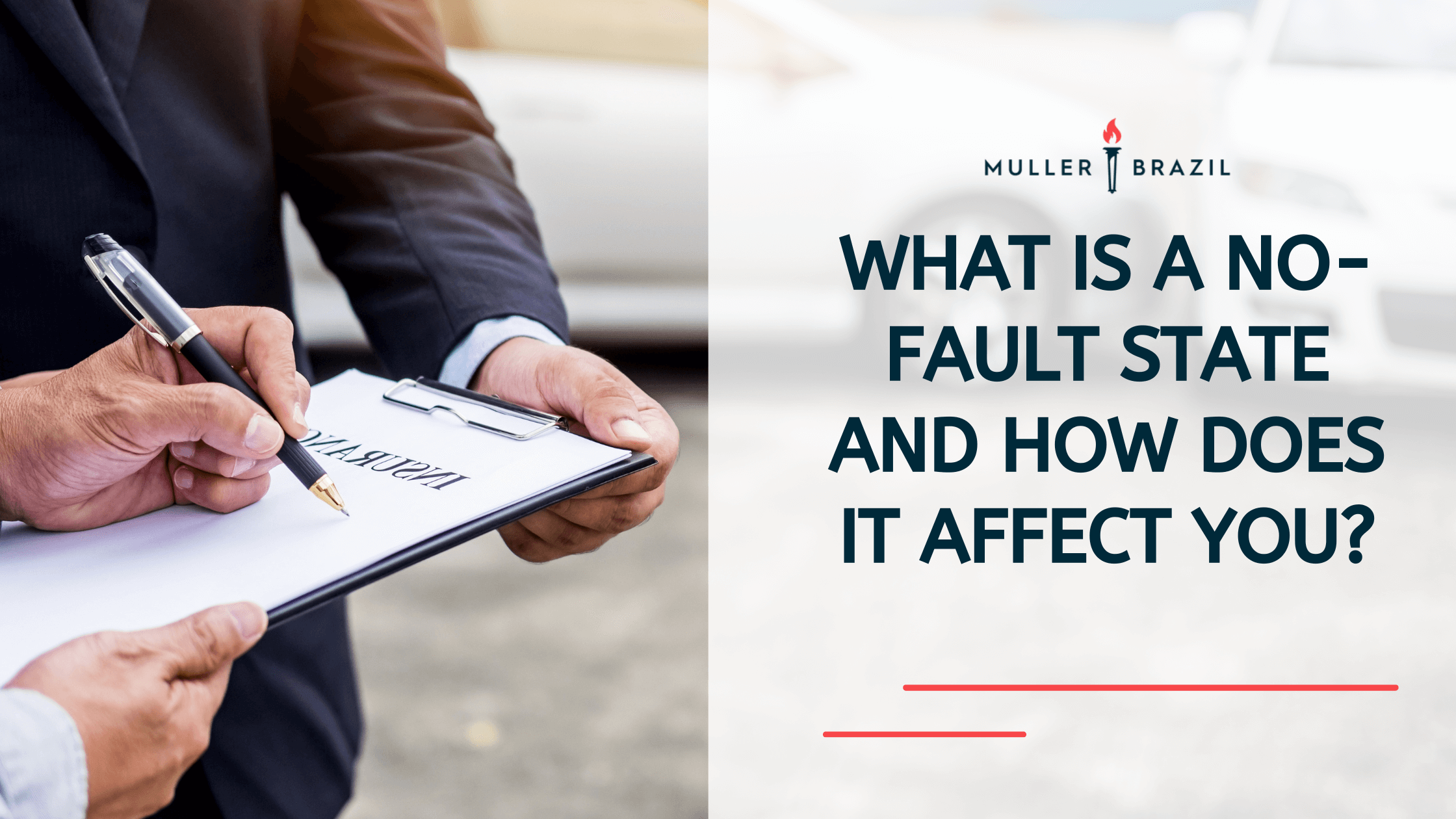7 min read
What Is a No-Fault State? Understanding Car Insurance
![]() Paul R. Brazil, Esquire
Mar 14, 2024 12:00:00 PM
Paul R. Brazil, Esquire
Mar 14, 2024 12:00:00 PM
Imagine being in a car accident and knowing that your medical bills and lost wages are covered—no lengthy lawsuits, no waiting to prove fault. That’s the reality in no-fault states, where your own insurance takes care of your expenses through Personal Injury Protection (PIP). While you might pay slightly higher premiums, this system offers peace of mind by guaranteeing quick access to essential financial support. Understanding how no-fault insurance works isn’t just smart—it’s crucial for making informed decisions that can protect you when the unexpected happens.
What Is a No-Fault State? Understanding How No-Fault Insurance Works
Within auto insurance, a “no-fault state” is a jurisdiction where drivers submit claims to their own insurance company, regardless of who caused the accident. This approach is designed to streamline the insurance process by removing the need to establish fault, thus reducing court costs and insurance premiums.
Each insurance company in these no-fault insurance states is responsible for covering their policyholder's medical expenses and the policy holders are required to carry personal injury protection insurance (PIP).
This system paves the way for quicker payouts and less litigation, making it an efficient alternative to the traditional fault-based system. It's a key aspect to consider when you buy no-fault insurance, as it influences how your claims will be handled.
What is the difference between an at-fault state and a no-fault state?
In an at-fault state, the driver who is determined to be responsible for the accident must pay for the damages caused, including medical bills, through their liability insurance. In contrast, a no-fault state requires drivers to file claims with their own insurance company (regardless of fault) to cover medical expenses through PIP coverage, limiting the ability to sue unless the injuries meet certain thresholds.
Key Principles of No-Fault Insurance Laws: What You Need to Know
At the heart of no-fault insurance laws lies a component known as Personal Injury Protection (PIP). Required in certain states, it covers the following regardless of who caused the accident:
- Medical expenses
- Loss of income
- Among other costs
But how does PIP coverage work, and how does it affect your ability to sue in a no-fault state?
How Personal Injury Protection (PIP) Acts as Your Financial Safety Net After an Accident
No-fault insurance relies on Personal Injury Protection (PIP) coverage, considered a cornerstone of the system. This coverage helps to provide:
- Medical expenses
- Lost wages
- Rehabilitative costs
- Key services like childcare
- Other costs like funeral expenses
This coverage extends to additional expenses not included under MedPay insurance, making it a crucial safety net for covering car-related injuries that may be excluded from health insurance policies.
In 15 states, PIP coverage is mandatory, ensuring coverage for drivers and their passengers after accidents. These benefits are coordinated with health insurance in certain states, covering:
- Physical injuries
- Additional economic losses, such as wages lost during hospitalization
- Payment for services that the injured can no longer perform
- Financial support for funeral expenses
PIP's financial benefits don't just stop at compensation for lost earnings due to injury but can sometimes extend towards financial support for funeral expenses.
Here are the 16 current No-Fault states and the minimum PIP coverage:
State Minimum PIP Coverage
Florida $10,000
Hawaii $10,000
Kansas $4,500
Kentucky $10,000
Massachusetts $8,000
Michigan $50,000
Minnesota $40,000
New Jersey $15,000
New York $50,000
North Dakota $30,000
Pennsylvania $5,000
Utah None
In some states, no-fault insurance coverage is optional. These include Washington, Virginia, Arkansas, South Dakota, and New Hampshire. Certain at-fault (tort) states also allow drivers to purchase no-fault insurance. These include Arkansas, Delaware, Maryland, Oregon, and Texas.
When Can You Sue in a No-Fault State?
While the no-fault system offers many benefits, it restricts the ability to sue. In no-fault states, drivers may only sue at-fault drivers if their medical bills exceed a state-specified monetary threshold based on the minimum personal injury protection (PIP) requirements that differ from state to state.
The ability to file a personal injury lawsuit in no-fault states is restricted by the ‘serious injury' threshold, which typically includes conditions like:
- Dismemberment
- Significant disfigurement
- Loss of a fetus
If medical expenses for serious injuries such as these exceed PIP coverage, victims may file a lawsuit against the at-fault driver for additional compensation.
Emotional distress damages, considered part of ‘pain and suffering,' can be claimed in no-fault states if the emotional trauma is severe and has a direct link to the suffered car accident.
How No-Fault Insurance Affects Your Car Accident Claims: What to Expect
The procedure for filing a claim after a car accident largely depends on whether your residence is in a no-fault state. In these states, PIP coverage does not extend to non-economic damages such as pain and suffering, thus limiting the ability of injured parties to claim these damages through their own insurance. The whole premise of no-fault insurance is to:
- Limit personal injury lawsuits
- Ensure prompt payment for medical and wage loss claims without determining fault
- Covered under personal injury protection (PIP) up to policy limits.
However, it's important to note that while no-fault insurance covers medical and other specified expenses, it does not cover property damage or vehicle repairs; these are usually covered under liability insurance and collision insurance, respectively.
In no-fault states, the claims process is streamlined as each party deals with their own insurance company regardless of fault. Still, filing claims for property damage can involve making claims against the other person's liability coverage, and personal injury lawsuits are limited for minor injuries.
How Do No-Fault Laws Affect Your Auto Insurance Policy?
No-fault laws directly influence your auto insurance policy. In no-fault states, auto insurance premiums are generally higher than at-fault states. This difference in premiums is due to varying regulations and coverage requirements. The rates are influenced by the coverage limit of no-fault policies and the cost of personal injury protection, which varies by the state and chosen deductibles.
Even in no-fault states, fault is still assessed for the purpose of risk evaluation and deciding future premium adjustments. If the policyholder is at fault, their premiums increase unless they have coverage like Accident Forgiveness.
As no-fault insurance laws can change, staying current with local requirements through a local agent is important to ensure that one's policy complies with state requirements.
What Are the Pros and Cons of No-Fault Insurance Coverage?
As with any insurance coverage, no-fault insurance comes with its own pros and cons. On the positive side, no-fault benefits, such as faster claim resolutions, may be experienced by eliminating the need to establish fault through lengthy legal proceedings, which can speed up compensation for injured parties.
However, a limitation of no-fault insurance is that it generally does not cover non-economic damages, such as pain and suffering, unlike at-fault systems, which may offer broader compensation. Moreover, in certain no-fault states, the PIP coverage limit is set at an amount that may not be adequate for severe injuries, forcing injured parties to file a personal injury claim for additional compensation.
How Does No-Fault Insurance Compare to At-Fault Insurance?
Understanding the key differences is vital when comparing no-fault and at-fault insurance systems. In no-fault states, drivers file a claim with their own insurance coverage. It doesn't matter who caused the accident. On the other hand, in at-fault states, the at-fault driver's insurance company is responsible for all claim expenses.
In states without no-fault insurance, known as ‘tort states,' the insurance company of the individual found to be at fault pays for all damage costs in the event of an accident. Furthermore, in tort liability states, the injured party can sue the at-fault driver and file a claim with the at-fault driver's insurance company. However, in no-fault states, there are restrictions on suing other drivers.
The difference between no-fault and at fault states lies in how claims are paid and the laws determining negligence and fault assessment, which vary between states.
Here is a basic breakdown of the differences:
Feature No-Fault At-Fault
Driver files claim with own insurance (regardless of fault) ✓ ❌
Restrictions on suing other drivers ✓ ❌
Injured party can sue at-fault driver ❌ ✓
Laws on negligence and fault assessment vary ✓ ✓
What Are Add-On and Choice No-Fault States, and How Do They Work?
Certain states offer drivers the option to choose between no-fault auto insurance and a traditional tort liability policy. Known as choice no-fault states, these include Kentucky, New Jersey, and Pennsylvania. Within this system, drivers can select a policy with either verbal or monetary threshold options, influencing their ability to sue for damages.
Some states, such as Arkansas, Delaware, and Maryland, use the add-on system. These states provide first-party benefits without restricting the right to sue, blending no-fault and tort systems. Add-on no-fault insurance allows drivers to supplement their auto insurance policy with additional personal injury protection, which is voluntary in some states and mandatory in others.
Read more about the specifics of no fault insurance in Pennsylvania.
.jpg?width=437&height=246&name=What%20does%20PIP%20insurance%20cover%20(2).jpg)
What Are the Steps for Filing a No-Fault Insurance Claim?
The procedure for filing a claim in a no-fault state is quite specific. After a car accident, it's important to:
- Contact your insurance company immediately
- Exchange insurance information with the other driver
- Take photos of the damage and scene
- Obtain the police report
- Retain physical evidence
- Record witness statements
- Compile accident reports
These steps are vital when supporting your claim.
Next, you'll need to:
- Submit your insurance claim within the specified time limit, typically 30 days
- Ensure compliance with your policy's PIP requirements and any specific state filing rules
- In case of claim denial, request the reason in writing
- Preserve all insurance communications
- Understand the steps for appealing the decision.
Why Should You Consult a No-Fault Insurance Lawyer After an Accident?
Dealing with the complexities of no-fault insurance laws can pose a challenge. Consulting with a no-fault insurance lawyer, confirms that you have someone dedicated to your case who can help you through the complicated legal processes following a car accident.
A no-fault insurance lawyer can ensure that you receive fair compensation based on the extent of your injuries and the specifics of your case, especially if difficulties arise with your claim. For those in no-fault states, consulting with a Philadelphia car accident lawyer is recommended to accurately assess the possibility of meeting the serious injury threshold that would allow for litigation against another party.
During the challenging time that follows an accident, a no-fault insurance lawyer provides legal assistance and lifts the burden from your shoulders, offering support through the recovery and claim process.
Take Control of Your Insurance: Get the Answers You Need Now
Understanding car insurance in no-fault states can feel confusing, but it’s important to know how the system works, how it affects your claims, and what it means for your policy.
Whether you’re deciding between no-fault and at-fault coverage or figuring out when you can file a lawsuit, staying informed is key to protecting yourself after an accident.
Don’t put it off! If you've been in an accident or have questions about your coverage, reach out to Muller Brazil today. Our team is here to help you understand your options and make the right decisions. Plus, our consultations are always free, so there’s no risk in getting expert advice.
Contact us now and guarantee that you are fully protected when it matters most!
Frequently Asked Questions
What are the no-fault states in the US?
There are 16 no-fault states in the US, including Florida, Hawaii, Pennsylvania and New Jersey. These states have specific insurance laws in place.
What is the advantage of a no-fault system for states?
The advantage of a no-fault system for states is that it reduces lawsuits after car accidents, decreases legal expenses, and provides quicker access to medical coverage for individuals involved in accidents.
Is Pennsylvania a no-fault insurance state?
Yes, Pennsylvania is a no-fault state, which means drivers must carry personal injury protection (PIP) insurance of $5,000 or more to cover medical expenses and lost wages regardless of fault.
What does Personal Injury Protection (PIP) cover?
Personal Injury Protection (PIP) covers medical bills, rehabilitative costs, lost wages, key services like childcare, and sometimes even funeral expenses after a car accident. It provides comprehensive support for accident-related expenses.
Meet the Author
Paul Brazil - Founding Partner
Paul Brazil is a native of Dunmore, Pennsylvania and a graduate of Dunmore High School. For his undergraduate education, he attended Bloomsburg University where he majored in political science. He then went on to earn his JD from Widener University School of Law. Following graduation from law school, Mr. Brazil worked at a large Philadelphia civil defense firm where he litigated workers’ compensation claims and Heart and Lung Act cases.
Learn more about Paul Brazil ⇒





